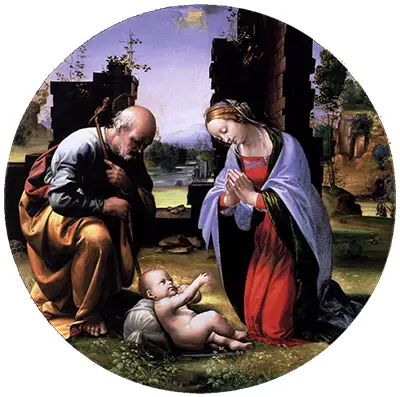Although the symbolism of kneeling in the presence of the Christ child is typical of many of these images, there is a real sense of tenderness in this scene, conveyed in the expressions on the faces of Mary and Joseph, as well as the gentle grace in the posture of each and the softness in the folds and lines of their garments.
This is a very intimate scene; although the figures are outside, there is no-one else around. It is as though we have been allowed to see this private moment between the three of them, almost as if we are intruding on their privacy. Mary leans towards her son, her hands clasped in prayer, while Joseph looks down upon the child with a fatherly gaze as if contemplating all that this child might become.
It is interesting that the infant is depicted reaching out to Mary. Certainly, it would be natural for the baby to reach out to the mother, but there is also an argument that the Son of God is reaching out to Mary who is his true mother, as opposed to reaching towards Joseph, his corporeal father-figure.
The composition of the painting shows the classical triangular arrangement of the protagonists which serves a number of purposes. In paintings of Christ as an adult, the figure of Christ will usually be at the top of the triangle with the other figures looking or reaching up, as the physical elevation also represents Christ’s spiritual elevation above others.
However, in Madonna and Child with St Joseph, Christ is actually at the bottom of the formation. This makes sense because the infant is obviously small and unless the other figures were holding him aloft, it would be an unusual composition for the infant to be above the others.
Yet this is an extremely clever painting in that the positions of the two adult figures draw your eye to the child lying on the ground, still making Christ the focal point of the piece. The heads of Mary and Joseph lean towards each other and we follow their gaze down so that we are all looking at the child.
The triangular arrangement is often used to draw the eye to a specific element in the picture, and sometimes to even lead the eye in a certain pattern.
The background in the scene is not intrusive so we have the content of the foreground all to ourselves. The eye is drawn up the bodies of the leaning figures and down to the ground between them.
It is not only the composition that creates this effect, but also Da Vinci’s use of colour. Notice how the intense black shadow of Mary’s sleeve almost acts like an arrow pointing our focus downwards, as does the angle of St Joseph’s staff and dark shadows of his robes.
Spotlighting is another common technique, working to perfect effect in this painting, illuminating the infant and carrying the main lighting down through the centre of the scene. By balancing this light and colour in the middle ground and distance, Da Vinci has given a more natural feel to this tender painting.


